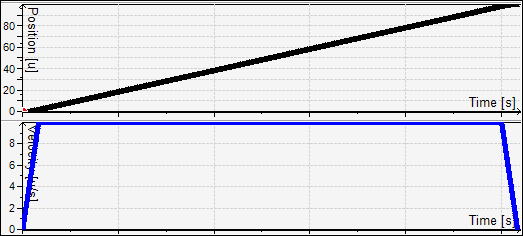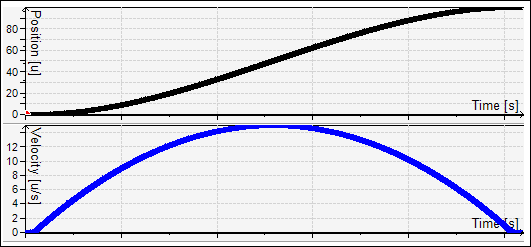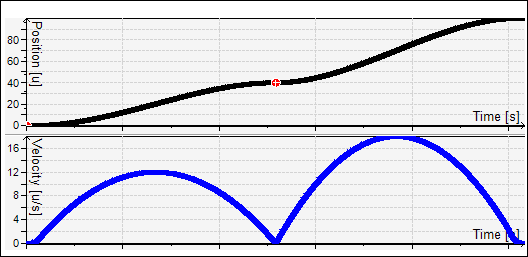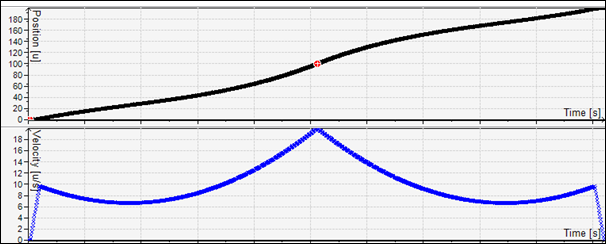Additional Spline Axes A, B, C
Function: The words A, B, and C define the target positions for spline additional axes. In principle, the additional axes act like P, Q, U, V, and W, whereby they depends on the relative path position on the path element instead of linearly by means of a polynomial function.
Note
Using A, B, or C excludes the use of the additional axes U, V, and W, because U, V, and W define the gradient.
Examples
G code
N10 G0 X0 A0 P0 F10 E30 E-30
N20 G1 X100 A100 P100
The linear additional axis P is interpolated linearly to the traveled path. Accordingly, its time profile returns that of the path velocity.

The additional spline axis A is interpolated as a polynomial function.

Additional axis P
Using the spline function is necessary, especially if a path with constant tangent transitions is used, which the interpolator does not have to decelerate to velocity 0:
G code
N10 G0 X0 A0 P0 F10 E30 E-30
N20 G1 X50 A40 P40
N30 G1 X100 A100 P100
In the linear case, you see a jump in the velocity, because 40 units of the additional axis travel on 50 path units in the first part, and 60 units of the additional axis travel on 50 path units in the second part. Because the path velocity defines (XYZ) only after the path Cartesian space, a constant velocity in X causes a velocity jump in P:

The spline axis displays the following profile:

Additional axis U
The slope of the axes A, B, and C at the end position can be defined by the U, V, and W word. The unit of the slope is the path unit of the additional axis per path unit in the space.
G code
N10 G0 X0 A0 F10 E30 E-30
N20 G1 X100 A100 U2
N30 G1 X200 A200
The user-programmed slope (U=2) of the A axis applies because this program contains a continuous transition between N20 and N30. Therefore, for X=100 the position of the A axis increases two times as fast as the path length.

Using A, B, or C excludes the use of the additional axes U, V, and W, because U, V, and W define the slope.
The function blocks SMC_SmoothPath, SMC_SmoothMerge, SMC_SmoothBSpline, and SMC_RecomputeABCSlopes determine the pitch of the additional axes automatically. This means that the definition of U, V, or W is not necessary.
The axes A, B, or C can be selected with bits 3, 4, or 5 at the wAxis input of SMC_LimitDynamics or wAddAxis of SMC_CheckForLimits .
The data structure SMC_ADDAXIS was extended by the elements ADDAXIS_A, ADDAXIS_B, and ADDAXIS_C.
See also